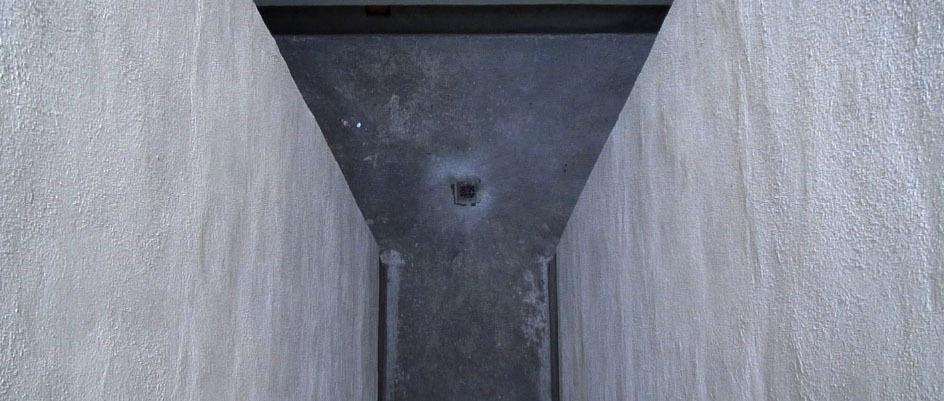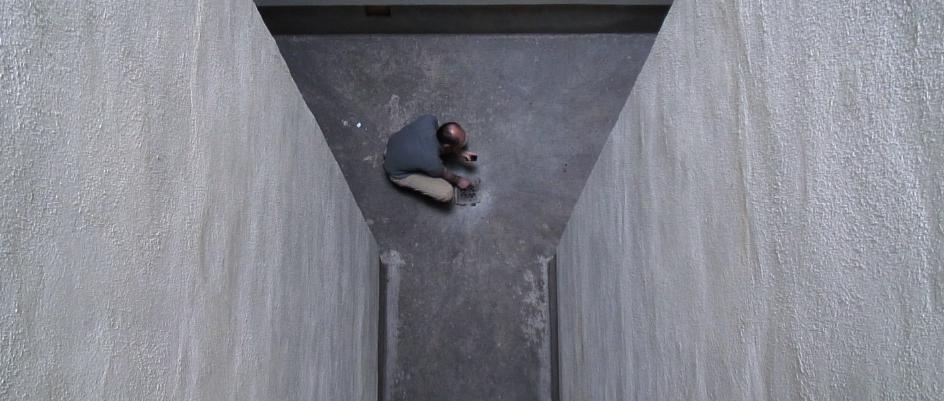Laws of Physics
The film begins with an image that looks like a schematic frontal view of a funnel; like a kitchen appliance that various things go into and then come out again – mixed. Another funnel of sorts is shown at the end of the film: a drain in a concrete floor. The grated drain fills the frame and dissolves microscopically; our gaze is lost in it.
In between is a take, a fifteen-minute zoom. Like every film image, the picture is both three-dimensional and flat – only here, one feels it. The view is out of a window down into an empty courtyard (that, too, is a type of funnel) and at the same time, it is geometrically abstract. Arising from this flickering between space and surfaces is time, a time that lasts longer than fifteen minutes. In other words: the picture is uncertain, it flickers, shows more than the eye can see. The less there is to see, the more there is that looks out at us from the image. The time in the funnel is that of a ghost. Cinephile memories haunt in the blend, from Michael Snow´s Wavelength zoom through to Hitchcock images that draw in the gaze: Rear window, the drain from Strangers on a Train, the shower drain in Psycho.
Michael Palm is a filmmaker working with a blend of documentaries, essay films, and paranoia thrillers, conjuring up spirits in the sound design. Where do the sounds and noises in the courtyard come from? From the room, off camera? From the telephone call that man who briefly appears in the picture (Palm himself) is involved in? Or perhaps even from the drain? Is someone there? Why else would we zoom endlessly into the drain that a little spider even crawls out of at one point? Could that be a coincidence? Everything that comes out must have previously gone in. We expect reasons, project secrets, and are forced to steadily revise our perception: The laws of physics for the eyes, are for the gaze and the cinema, the inescapability of wanting to see something. Laws of Physics plays with these laws: a veritable mind game movie.
(Drehli Robnik)
Translation: Lisa Rosenblatt
dialogue list laws of physics
0:39 (female voice, off-screen)
Get on the bed! Get on the bed! Lets get started! I feel bad... no I dont.
2:45 (male character, on-screen, phone call)
Hello!?
Yes, well...
Thank you very much, thank you!
Aha, yes, well, youre really very nice. Yes.
Uh, but...I know, uh...
Yes, I found him, yes.
What I wanted to talk to you about was, uhm....
How did you put it in the appartment?
Aha...
What about the alarm?
Great.
Well, see, I am perfectly happy...nothing of value.
No, nothing personal except my keys!
I thought I have the only key.
Yes, I really would like to have the only copy of this, but...
I dont remember telling you.
...
How do you know of my birthday?
Would you like to take a guess how old I am?
Nah...
Hello?
Well, thats a very good guess.
Bye!
8.45 (female voice, off-screen)
No, dont! I have no idea...
LAWS OF PHYSICS DIALOGLISTE:
0.39 (weibliche Stimme, off)
Geh aufs Bett! Geh aufs Bett! Fangen wir an! Mir geht es schlecht...nein, doch nicht.
2:45 (männliche Figur, on, Telefongespräch)
Hallo?
Ja, aber...
Vielen Dank, danke!
Aha, ja, Sie sind wirklich sehr nett. Ja.
Äh, aber...ich weiß, äh...
Ja, ich habe ihn gefunden, ja.
Worüber ich mit Ihnen sprechen wollte, war, äh..
Wie haben Sie es in die Wohnung gebracht?
Aha...
Was war mit dem Alarm?
Toll.
Schauen Sie, ich bin sehr froh...nichts Wertvolles.
Nein, nichts Persönliches bis auf meine Schlüssel! Ich dachte, ich habe den einzigen Schlüssel. Ja, ich würde wirklich gerne die einzige Kopie davon haben, aber...
Ich kann mich nicht erinnern, Ihnen davon erzählt zu haben.
Woher wissen Sie von meinem Geburtstag?
Möchten Sie schätzen, wie alt ich bin?
Nein...
Hallo?
Das ist sehr gut geschätzt!
Auf Wiederhören!
8.45 (weibliche Stimme, off)
Nein, nicht! Ich weiß es nicht....
Laws of Physics, Texte français
Entre ces deux pôles, un plan : un zoom de 15 minutes. L'image est à la fois spatiale et plane comme toute image cinématographique. Sauf qu'ici, on s'en rend compte. C'est le regard que l'on jette du haut d'une fenêtre sur une cour vide (là aussi une sorte d'entonnoir), mais c'est aussi une abstraction géométrique. De la tension vibrante entre espace et surface naît le temps, un temps qui dure bien plus qu'un laps de 15 minutes. Ou, en d'autres termes : l'image est incertaine, elle vibre, montre plus que l'il ne peut percevoir ; moins il y a à voir, plus l'image nous regarde. Le temps dans l'entonnoir est un temps spectral. Des réminiscences cinéphiles hantent le montage, du zoom de Wavelength de Michael Snow aux images de Hitchcock qui aspirent le regard : Fenêtre sur cour, la bouche d'égout de L'inconnu du Nord-Express, la bonde de la douche dans Psycho.
Michael Palm est un réalisateur qui mixe documentaire, film d'art et d'essai et thriller paranoïaque, et qui invoque les esprits dans son montage son. D'où proviennent les voix et les bruits de la cour ? De la chambre, en off ? Du coup de fil que donne l'homme (Palm lui-même) aperçu brièvement à l'écran ? Ou même de la bonde de la douche ? Y a-t-il quelqu'un ? Et sinon, pourquoi le zoom se rapproche-t-il interminablement de la bonde d'où s'échappe même une petite araignée ? Est-ce vraiment un hasard ? Pour pouvoir sortir, il faut être entré. Nous cherchons des raisons, imaginons des secrets, et sommes sans cesse forcés de corriger notre perception : les lois de la physique sont à l'il ce qu'est l'inexorabilité du désir de voir au regard et au cinéma. C'est avec ces lois que joue Laws of Physics : un vrai jeu de réflexion façon cinéma. (Drehli Robnik)
Traduction: Françoise Guiguet
Jurybegründung für "Preis für Innovatives Kino", Diagonale 2009 (Award)
Eine einzige Einstellung, eine kurze Spielhandlung, eine langsame Kamerafahrt, dann gerät der Film an seine buchstäbliche Grenze. Mehr braucht Michael Palm in Laws of Physics nicht, um einen filmischen Raum und eine filmische Zeit zu öffnen, in der zahlreiche Referenzen zur Geschichte des experimentellen Films Raum und Zeit haben. Dazu nutzt der Regisseur sinnvoll und präzise die Möglichkeiten des digitalen Mediums und fordert die Zuschauer in ihrer Aufmerksamkeit und ihrem Wissen heraus. Das ist es im Grunde, was wir uns von einem Preisträgerfilm der Kategorie Innovatives Kino" erwarten.
Jury:
Reinhard Braun (freier Autor und Kurator, AT)
Eve Heller Tscherkassky (Filmemacherin, US/AT)
Maria Morata (freie Kuratorin/Programmer Film/Video, ES/DE)
Pressestimmen (DE & EN)
Claudia Siefen, In: SENSES OF CINEMA
Am Anfang ist ein leerer Raum. Eine klare geometrische Struktur, die in die Tiefe weist, rohe Betonwände und ganz hinten eine kleine dunkle Öffnung. Dann tritt einer ins Bild. Neuorientierung wird möglich. Aber was es genau mit der räumlichen und technischen Anlage auf sich hat, die hier wirksam wird, das lässt sich erst mit der Zeit entschlüsseln. Ein Rest an Mysterium bleibt.
Isabella Reicher, In: DER STANDARD
... ein bemerkenswertes Raum-Zeit-Experiment.
Christoph Huber, In: DIE PRESSE
Ein buchstäblich geradliniger, filmischer Belastungstest für das gerechnete Bild.
Dominik Kamalzadeh, In: DER STANDARD
... langsam und intensiv ...
Martin Behr, In: SALZBURGER NACHRICHTEN
Laws of Physics
2008
Austria
15 min



